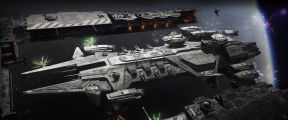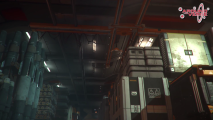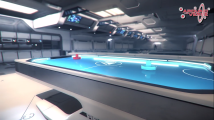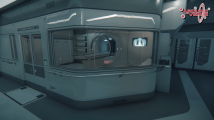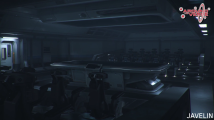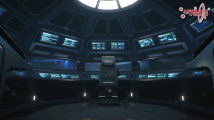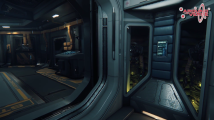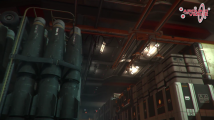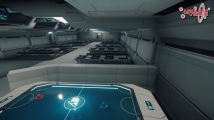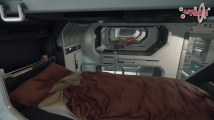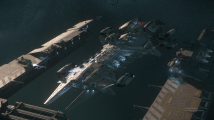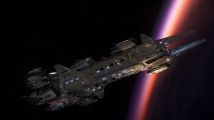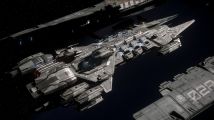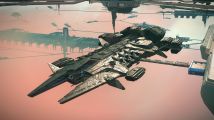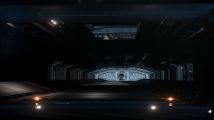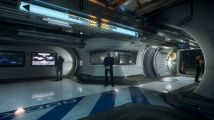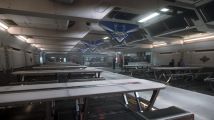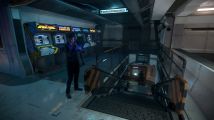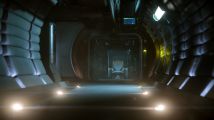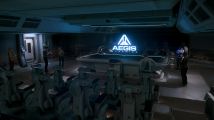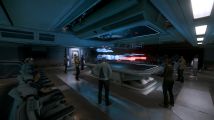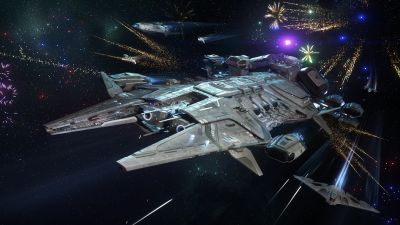 | |
| Gyártás állapota | |
|---|---|
| Javelin | |
| Gyártó | Aegis Dynamics (AEGS) |
| Szerepkör | Destroyer |
| Hangar típusa | Capital |
| Helyettesítő jármű | Hammerhead, Vanguard Harbinger, MPUV Cargo |
| Általános adatok | |
| Legénység | 12 – 80 |
| Raktér | 5,400 SCU |
| Költségek | |
Vételár
Nem elérhető
Bérlés
Nem elérhető
Standalone
$3,000
S. orig.
$2,500
Warbond
$2,700
W. orig.
$2,700
Elérhetőség
Quantity-limited sales
Igénylés
Not available
Bérlés
Nem elérhető
| |
| Specifikációk | |
| Hosszúság | 480 m |
| Szélesség | 198 m |
| Magasság | 72 m |
| Tömeg | 109,860,179 kg |
| Lore | |
| Bevezetés | 2690 CE |
The Aegis Javelin is a destroyer utilized by the United Empire of Earth Navy (UEEN). Designed as a modular spacecraft, the UEEN could make major conversions to the Javelin for different roles rather than constructing individual specialized capital ships. Javelins are used as convoy escorts, fleet support, orbital fire suppression, reconnaissance in force, and fast interception missions. Surplus Javelins have been sold on the civilian market.[1] The ship features a total of five decks, each with a variety of crew positions and areas to explore and utilize.[2]
Specifications
Layout
The Javelin’s heavily armored bridge looks out over the rest of the ship’s superstructure. Centered around a fleet-class command-and-control interface, the bridge allows a dozen crewman to have full run of both the destroyer’s facilities and eye-on awareness of its deep space environs. Bridge positions include captain, executive officer, communications, weapons, radar, helm and science positions. The bridge is surrounded by escape pods designed to allow the entire command team to make a quick egress should the worst happen. These escape pods, which can be found throughout the ship, are designed to carry five crew each. These escape pods are military-spec, oriented for easy retrieval by unladen Argo transport ships.
The Javelin’s Top Deck, also known as ‘officer country,’ is home to quarters for the ship’s captain and executive officer, with all the comforts of home. The prime attraction of the Top Deck is six modular rooms and the upper hangar (used for smaller launches or cargo.) Aegis Dynamics produces an array of battle-oriented room modules which can easily be slotted in and out of place while the Javelin is on orbit; a number of other manufacturers are now creating aftermarket modules for civilian roles such like science and cartography. Additional escape pods for officers are present on the top deck. Javelin isn’t just a name; the ship’s internal layout philosophy is based around long, straight ‘javelin’ corridors. Right angle turns are used almost exclusively to connect to more long, straight corridors, giving the ship an overall cramped but stretched feel.
Mid-Deck aboard a Javelin is where the real work happens. It includes access to two torpedo bays and six turret emplacements, giving the ship both offensive and defensive capabilities. The Javelin’s engine column is located here, and the Navy advises that it be staffed at all times for optimal performance. Onboard communications connects the engine column directly to the command stations on the bridge. Two of the modular component rooms can be slotted on to the mid-deck. The ship’s left flank includes access to the hangar, medical bay and brig, while the right flank includes two sets of crew quarters, showers, toilets and the mess hall. Mid-deck also includes escape pods. Each deck is given a specific function and in the case of the mid-deck, divided laterally with crew habitation and functions placed on the right and military functions on the left. The sub-decks are reserved for engineering and turret access with their cramped, dimly lit corridors reflecting their utilitarian maintenance purpose.
The Javelin’s bottom deck includes six dedicated cargo rooms, two engineering facilities and access to the engine column. From the engine column, crew can access two STS turrets and four of the modular component rooms. The Javelin’s main hangar is also located in this area. While smaller than a dedicated carrier’s hangar, the Javelin can still accommodate a limited number of individual spacecraft. The hangar is primarily designed to deploy a single Aegis Redeemer gunship and a crew of Marines for boarding operations, but other ship types can also be stored. A chart of existing types is attached.
The Javelin has a pair of sub-decks with access to additional functionality. Sub-Deck 1 provides access to two modular component rooms, while Sub-Deck 2 features three Class 6 ATA turret emplacements and a maintenance EVA airlock. The Sub-Decks are the area most exposed to space, and are the best place to assign junior organization members. The ship’s six-total swappable ‘customizable rooms’ make the base Javelin a chassis that can be customized for different roles by switching these rooms. Although first and foremost a combat focused ship, this flexibility has allowed the Javelin to serve well beyond the life expectancy of other ships of its age.
Known Javelin destroyers
| Ship Name | Status | Known Captains | |
|---|---|---|---|
| UEES Flyssa | Destroyed: wrecked on Daymar in 2862[3] | Chin Ormiston | |
| UEES Orpheus Horizon | Destroyed: wrecked on Leir III[4] | Ted Patterson | |
| UEES War Hammer | Active Service[5] | Metcalf[6] |
Flights
There have been three Javelin Flights, detailed below.[7]
| Flight | Start of Production | End of Production | Retirement | Details |
|---|---|---|---|---|
| Flight 1 | 2690 | 2790 | Began 2810, complete by 2840 | The original model designed by Aegis Dynamics. Role-reassignment refits of this model would take several days in a shipyard. |
| Flight 2 | 2790 | 2820 | Began 2915 | A redesign that largely bypassed Aegis, focussing on interior improvements. This revision improved modularity, allowing rapid refits in the field. |
| Flight 3 | 2820 | Present | Earliest models being retired currently | Focused on defenses, reworking the shield system, and introducing point defense guns and sensors to increase anti-fighter coverage. As a result, the Javelin gained another major role, serving as part of a multi-ship bomber screen for larger fleet movements. |
Pledge price history
| Date | Pledge cost (USD) | Insurance | Availability | Sale |
|---|---|---|---|---|
| 2020-05-26 | 3000 | 120 months | Time-limited | Invictus 2950 [8] |
Gallery
Development
The Javelin is designed by David Hobbins (Freelance Conceptist) in 2014 and then worked on by the team in Foundry 42 UK.[2]
The Javelin was sold to backers in limited batches of 200 ships in 2014 and 2015 (for a total of 400 ships). The batches were described as an allotment of battle-tested 'surplus' ships and were sold stripped of weapon systems and with some wear. Organizations that plan to use the Javelin should expect additional costs due to repairs and upgrades before active use of the ship.[2]
See also
References
- ↑ Javelin - Galactapedia. Galactapedia
- ↑ 2.0 2.1 2.2 Introducing the Javelin-class destroyer. Transmission - Comm-Link
- ↑ Ben Lesnick. "Portfolio: the Fate of the UEES Flyssa". Jump Point. Vol. 8 no. 12. pp.37–39. Retrieved 2021-04-19.
- ↑ CitizenCon Presentation 2016 on Youtube, (Presentation starts at 01:25:19), accessed 2016-10-10.
- ↑ Save the Date: Invictus Fleet Week. Transmission - Comm-Link. Retrieved 2021-04-30
- ↑ https://youtu.be/VuMkh89zSk4?t=472
- ↑ Ben Lesnick. "Whitley's Guide: The Aegis Dynamics Javelin". Jump Point. Vol. 9 no. 6. pp.33–36. Retrieved 2021-06-25.
- ↑ Invictus 2950 Sale. Transmission - Comm-Link
